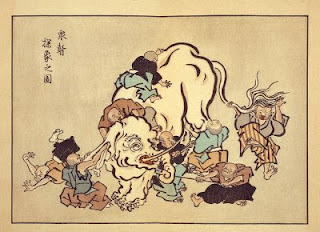
Last Friday, I introduced a story to the Kindergarten class I am working with
at the Gardner Pilot Academy, through their Young Audiences Friday Enrichment program. I call it "Six Blind Men Meet an Elephant", and it derives from the storytelling tradition of India. This tale is well-known throughout Asia, from Thailand to Japan, and has been interpreted according to the tenets of several religions, most notably Jain, Buddhism, Sufi Islam, and Hinduism. A nineteenth-century American poet is credited with first introducing this well-established narrative to a Western audience, in the form of a rhyming poem.
The story goes as follows:
Six blind men have long debated amongst themselves the concept of an elephant. Having heard differing stories from sighted individuals over the years concerning this creature, they each have their own notions as to whether it exists, and if it does, what its nature is.

Eventually, they are brought into the presence of a real living pachyderm, however this merely compounds the problem, since e
ach man - literally and figuratively - grasps only one part of the beast's anatomy. Meaning that while one man (who is holding the trunk) asserts that an elephant is a snake-like being, another (feeling a huge swaying ear) refutes the first's findings, claiming
that the elephant is delicate and ever-moving, like a fan. Each of the other four likewise pronounces with utter certainty and equal obstinacy as to the great mammal's physical qualities.
Their incessant debating is only halted when an observer - variously a king or a wise man - points out that, although each man is correct, none of them will possess the full and complete truth concerning the elephant's nature until he is willing to absorb and acknowledge the truth of his companions.
It's a marvelous story, and one that works well for children and adults of almost any age. My kindergarten class of 20 kids - we've been

gaining a student almost every week since school began!? - struck me as the perfect audience for a moral-bearing story of this sort, which seems simple, but actually goes pretty deeply into human psychology.
As individuals, we are often strongly convinced of our own correctness, as informed by the feedback we receive from the external world. However, each of us receives that feedback via the filtration system that is our individual brain and consciousness, which is formed in part out of our unique collection of prior experiences. These experiences precondition us toview our world and its inhabitants and occurrences from a perspective that, while generally human, is not identical to that of any other individual human. Whether we like it or not, as social beings, all humans depend on each other, to varying degrees, in order to more fully - if not absolutely - comprehend the complexity of our universe.
In other words, we can't all be absolutely right about everything all of the time. Even if we each secretly believe that we are. (That sound you hear is my husband trying not to chuckle.)
The story of the Blind Men and the Elephant has spread far beyond Asia, and has also moved beyond its role as a narrative with a moral. In fact, it is now often used as a kind of parable for any situation in which groups or individuals are not pooling their knowledge or resources, and thus missing a broader point. It's analogous to the old saw "missing the forestfor the trees."
A quick internet search reveals that this tale is used in a wide range of didactic and current topics, ranging from Cyberlaw to Business to Biomechanics, and more. But the most frightening and prescient contemporary analogue that I found is contained in the following cartoon:

Scary, no?
Attributions of images: 1st image Jain story, 2nd image "Blind Monks Examining an Elephant", 3rd image from "Contextures: the blog".